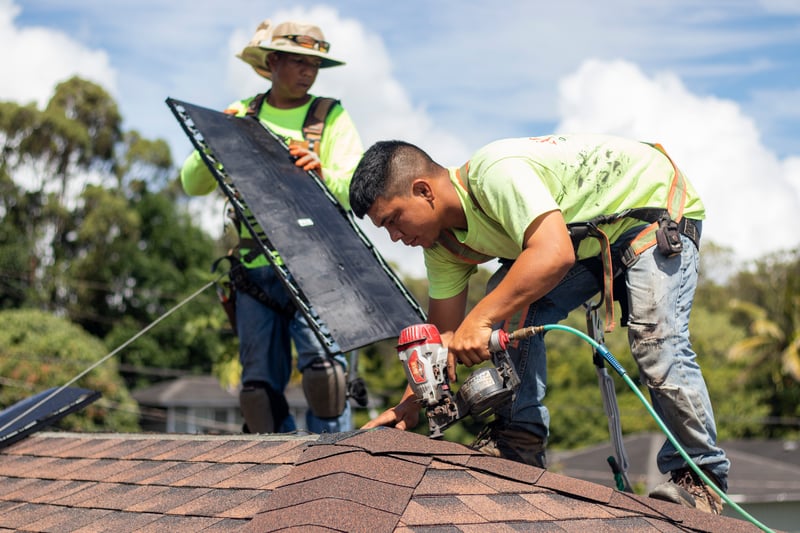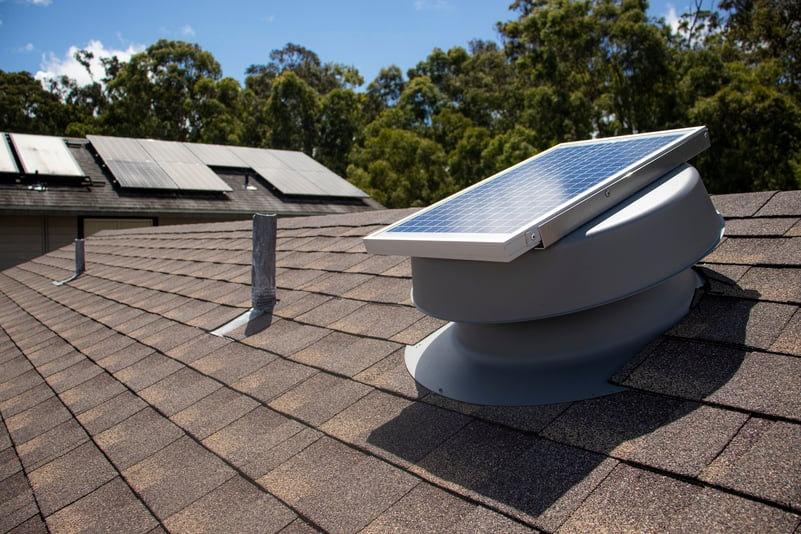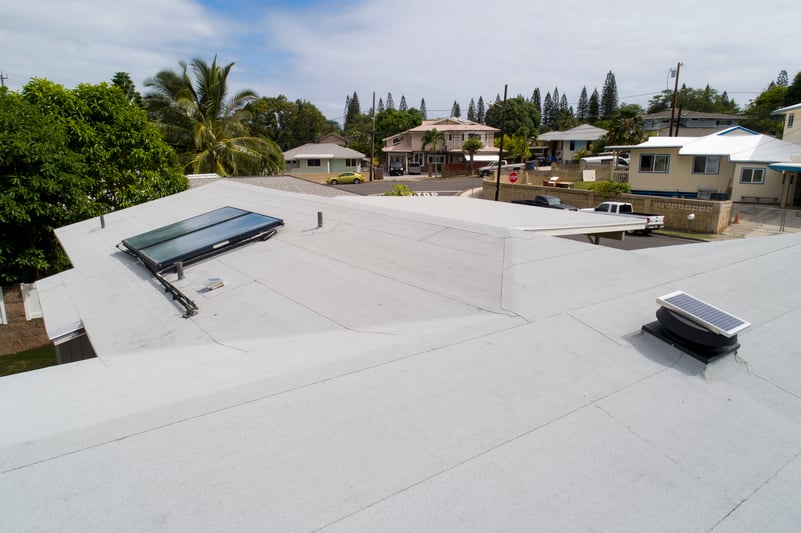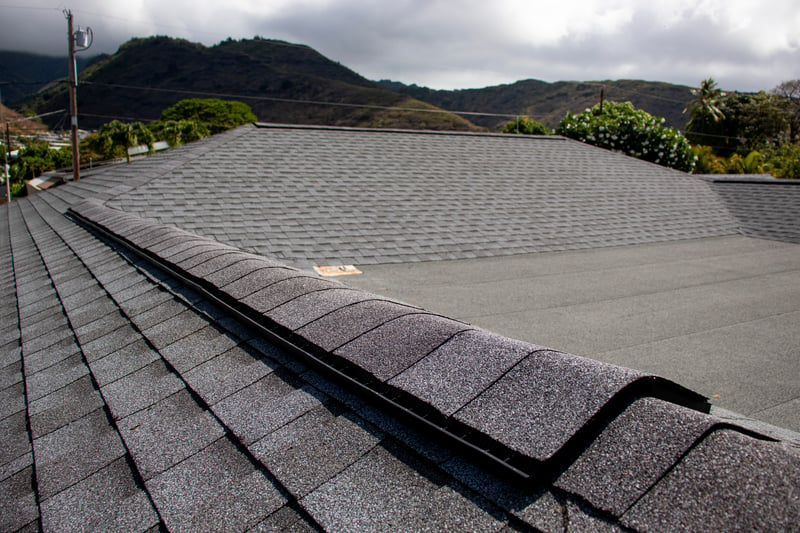Solar Fans vs Ridge Vents: Which Will Keep My House Cooler?
Living in Hawaii is a literal paradise! The cool ocean breezes, sunny weather, and unique culture among many other benefits are what make it home.
Living in this tropical paradise also comes with some unique challenges, like the intense heat and humidity that we experience ever year! Hawaii has one of the highest electrical costs in the nation, and many single wall homes lack the modern insulation to help buffer the heat.
Luckily for you, there are more ways to keep your home cool and properly ventilated other than AC usage. In this blog, we'll be discussing two of the most popular choices.
Solar Fans & Ridge Vents! They are both great products that are energy efficient and help properly ventilate your home.
While they both do an exceptional job at helping properly ventilating and circulating the hot air out in your home, the way they achieve those objectives are vastly different. We listed out a number of pros and cons for each system, to help you narrow down which choice is right for your home.
Solar Fans
.jpg?width=5464&name=Lawrenett%20Spencer%20(D8%20-%20Blog%20Crop).jpg)
Pros
Self Sustainable/Renewable Energy
Solar fans are powered just the same way solar panels do; utilizing energy directly from the sun. The power harnessed from the sunlight powers a motor that spins a fan to actively suck hot air out of your attic space!
While solar panels produce electricity for your home, solar fans use the energy from the sun to operate itself, separate from other electrical appliances in your house. Unlike solar panels however, solar fans don't need to be hooked up to work. They work directly from the roof without any additional appliances or wiring.
No Additional Cost To Electric Bill
After installation, Solar Fans have no cost to keep them running. That's right, no addition to your monthly electric bill! This is one of the most significant benefits of solar fans. It'll keep your home nice and cool during hottest parts of the day and prevent moisture building up in your attic space with no additional charge on your bill.
Simple Installation Process
There is no complicated process to have a solar panel installed and it saves the headache of having an electrician coming out to add more wires to your home. Solar Fans can be added to any roof type of roof, regardless of material, and after or even during a full reroof project. With that said, the job should always be done by a professional roofing contractor to ensure no leaks will result from the installation.
Cons
Needs adequate Sunlight
One trade off solar fans is that they will need proper sunlight to run efficiently, just like solar panels. If there is no adequate sunlight, such as during an overcast/rainy day or during the evening, the solar fan won't run. Especially here in Hawaii, the evenings can be exceptionally warm and humid and we do have a number of rainy days from time to time.
Higher Cost Than Static Ventilation Systems
While Solar Fans are more energy effective than other types of passive vents, they do have a higher upfront cost. That barrier to entry might be a turn off for some people, however a solar fan provides superior heat abatement and minimizes the need for more costly cooling methods. Once the upfront cost and installation are paid for, there will be no additional costs to have a Solar Fan run, unlike fans.
Might Require More Than One solar Fan System To Work Effectively
One key drawback of Solar Fans to be aware of is that they don't produce as much energy as other motorized option, so they won't be able to move as much CFM (Cubic Feet per Minute) of air. Before moving forward with a purchase, be sure to check that the solar fan will be able to cover the proper amount of square feet that needs to be vented in your living space. Sometimes two, or even three solar fans are required to properly ventilate a home. A professional roofing contractor can help you evaluate the amount of Solar Fans needed to properly ventilate your living space.
Ridge Vents
.jpg?width=6000&name=Wendy%20Lagareta%20-%20Ridge%20Vent%20(Blog%20Crop).jpg)
Pros
Low Maintenance, and highly effective!
A ridge vent is a passive form of ventilation that works exactly how it sounds... as air heats up, it rises... and the highest point of your roof is the ridge! Ridge vents provide a place for the hot air to escape, and create a draft that sucks in cool air near the intakes at your soffits. This means no mechanical parts, and a natural means to dissipate hot air our of your home.
Design Of Ridge Vents Work With The Look Of Your Roof
Works With All Types Of Weather Conditions
Since Ridge Vents don't need to be operated (moving mechanisms, motorized, or requires fuel), you won't have to worry about proper weather conditions to have Ridge Vents do their job. A ridge vent is a passive form of ventilation, and when it comes to passive venting... these are the best! They work purely by their design. Doesn't matter if it's a bright, hot sunny day, overcast rainy day, or even in the middle of the night; Ridge Vents will still be working regardless of the conditions.
Cons
Typically Only Works With Asphalt Shingle Roofs
As you may have noticed, Ridge Vents are typically only seen on asphalt shingle roofing systems. This ventilation system isn't compatible with most other types of roofing materials. One other roofing material Ridge Vents may also be applied to is tile roofs, but is far less common and the price range tends to be much steeper. Once again, it is always best to check with a professional roofing contractor to see if Ridge Vents will be compatible with your home.
Complex Installations
As the name suggests, ridge vents can only be installed at the very top of a roofing structure; the ridge. This systems isn't ideal for low sloped roofs and, as it turns out, very steep roofs. Ridge Vents are only effective when air is directed towards the vents; therefore, your home must have an energy-efficient design to help direct the flow of air to the top of the roof, where the Ridge Vents sit.
Could Leak During Heavy Rainfalls
While offering warm sunny skies most of the year, Hawaii also has some very inclement weather from time to time. Residents of Hawaii are area of this, so homeowners should also keep in mind that Ridge Vents are prone to leaks during very heavy rains. Due to it's design, if the rain falls at the right angle, the rain water could blow right in through the vents, and create water damage in your attic space. In most cases this doesn't happen very often, but it is something to keep in mind when opting for Ridge Vents.
Can Both Work Together On One Roof?
.jpg?width=960&name=George%20Lau%20-%20Blog%20(Crop).jpg)
Most experts say that combining Ridge Vents with Solar Fans is a bad idea. For the most part, there is truth to that. Having Ridge Vents and Solar Fans installed on the same roof could actually end up counter acting each other, not providing the proper circulation your roof needs, and not providing the best ROI spent on these ventilation upgrades. With that said, some roof systems are more complex than others and may actually need both systems in play to help properly vent living space. While Ridge Vents are suitable for one section of the roof, maybe there is a large flat section of roof not suitable for Ridge Vent installation, and that's where having Solar Fans installed could come into play.

At the end of the day, it is always best to consult a professional roofing contractor to evaluate what would be best for your roof. That's where team Kapili comes in! Here at Kapili Solar Roofing & Painting, we have years of experience working with both Ridge Vents and Solar Fan systems, having installed one or the other system on almost every residential job we do! Whether you have shingle roof, modified bitumen, metal, coating, or even tile, we're able to work with any material to help you get the proper ventilation your home needs! No job is too big or too small! Click below to contact us for a complimentary consultation today!
Schedule Complimentary Consultation!
%20(2).png?width=150&height=107&name=Solar%20Logo%20(No%20Background)%20(2).png)


.jpg?width=800&name=Wendy%20Obrock%20(C3).jpg)

Comments